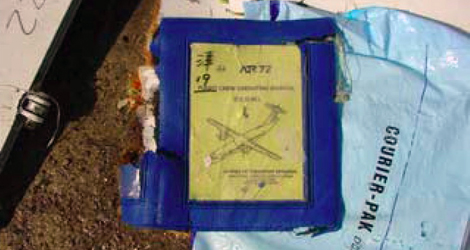
Flight recorder of Transasia Airways flight GE791 – ATR – ATR72-200 (B-22708)
On December 21, 2002, at 0152 Taipei local time, TransAsia Airways flight GE791 cargo, aircraft type ATR72-200, registration B-22708, encountered a severe icing during its flight and crashed into the sea 17 kilometers southwest of Makung city, Penghu Islands. Both pilots (CM-1 and CM-2) on board were missing.
Around 23:10, December 20, 2002, the flight crew arrived at TNA office at Chiang Kai-Shek (CKS) International Airport and was prepared to flight from CKS International Airport to Macau International Airport. About 0056, December 21, 2002, TransAsia Airways flight GE791 started engines from cargo apron 508.
It was airborne on Runway 06 at 0104 and via CANDY1 departure .
It reached the assigned flight level 180 (FL 180) at 01:25 and joined A-1 when passing MKG VOR/DME. According to the Meteorological Conditions data, the ground temperature was 20 degrees Celsius when GE791 departed from CKS International Airport and the estimate temperature at the altitude of 18,000 ft of accident area was minus 9 degrees Celsius.
The Flight Data Recorder (FDR) parameters of Transasia Airways flight GE791 showed that the airframe de-icing system was activated during the periods of 0134 to 0137 and 0141 to 0152 (when the FDR stopped recording) respectively.
According to the Cockpit Voice Recorder (CVR) transcript :
0132 CM-2: Looks like it’s iced up….look at my side your side is also iced up right
0134 CM-1: oh it is icing up
0144 CM-1: it’s iced up quite a huge chunk
0150:29 CM-1: Wow it’s a huge chunk
CM-2: what an ice
0150:55 CM-1: This speed is getting slower it was a hundred two hundred one hundred and ninety now one hundred seventy
After discussed with CM-1 for a short while; at 0151:38, CM-2 said: you want high or ah, it is severe icing.
After a discussion again, CM-2 at 0151:51 requested and approved from Air Traffic Control to descend to FL 160.
FDR data showed: GE791 began to descent at 0151:56
0152:02 CM-1: do you see that
0152:08 CM-1: it’s severe icing up
0152:10 CM-2: Captain
The CVR has recorded various warning sounds during the 40 seconds from 0152:11 to 0152:51 (when the CVR stopped recording).
0152:25 CM-2: Captain pull up. (This was the last dialogue between them.)
Furthermore, the FDR has shown:
When the aircraft reached and maintained FL180, the lowest indicated airspeed recorded was 157 knots at 0151:12 and the highest was 436 knots at 0152:50 when the FDR stopped recording. At 0152:12, the aircraft began pitching down. Starting from 0152:23.5 till the stop of FDR, the pitch angle exceeded 50 degrees all the time with 85.9 degrees the biggest one.
At 0152:09, a left bank developed and reached up to 48.9 degrees two seconds later. From then on, the bank degrees were constantly changing until the FDR stopped with the biggest one exceeding 90 degrees. The maximum vertical acceleration speed was 4.02G at 0152:45.375.
A disengage of the autopilot was recorded at 0152:11.
- The accident flight encountered severe icing conditions. The liquid water content and maximum droplet size were beyond the icing certification envelope of FAR/JAR 25 appendix C.
- TNA’s training and rating of aircraft severe icing for this pilots has not been 179 effective and the pilots have not developed a familiarity with the Note, CAUTION and WARNING set forth in Flight Crew Operating Manual and Airplane Flight Manual to adequately perform their duties.
- After the flight crew detected icing condition and the airframe de-icing system was activated twice, the flight crew did not read the relative Handbook, thereby the procedure was not able to inform the flight crew and to remind them of “be alert to severe icing detection”.
- The “unexpected decrease in speed” indicated by the airspeed indicator is an indication of severe icing.
- The flight crew did not respond to the severe icing conditions with pertinent alertness and situation awareness that the aircraft might have encountered conditions which was “outside that for which the aircraft was certificated and might seriously degrade the performance and controllability of the aircraft”.
- The flight crew was too late in detecting the severe icing conditions. After detection, they did not change altitude immediately, nor take other steps required in the Severe Icing Emergency Procedures.
- The aircraft was in an “unusual or uncontrolled rolling and pitching” state, and a stall occurred thereafter.
- After the aircraft had developed a stall and an abnormal attitude, the recovery maneuvering did not comply with the operating procedures and techniques for Recovery of Unusual Attitudes. The performance and controllability of the aircraft may have been seriously degraded by then. It cannot be confirmed whether the unusual attitudes of the aircraft could have been recovered if the crew’s operation had complied with the relevant procedures and techniques.
- During the first 25 minutes, the extra drag increased about 100 counts, inducing a speed diminishing about 10 knots.
- During the airframe de-icing system was intermittently switched off, it is highly probable that residual ice covered on the wings of the aircraft.
- Four minutes prior to autopilot disengaged, the extra drag increased about 500 counts, and airspeed decayed to 158 knots, and lift-drag ratio loss about 64% rapidly.
- During the 10s before the roll upset, the longitudinal and lateral stability has been modified by the severe ice accumulated on the wings producing the flow separation. Before autopilot disengaged, the aerodynamic of the aircraft (lift/drag) was degraded of about 40%.
Download Report


0 Comments